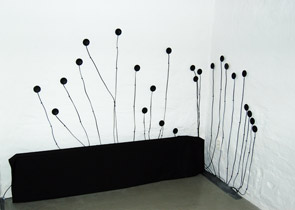Klang-garten [timbral automata]
Thanos Chrysakis (GR)
Generative Electronic Music for n mini-speakers
Klang-Garten [Timbral Automata] was originally conceived and designed for the radio project rand 0% (an automated net radio station streaming real-time generative music. All audio is generated by algorithmic software applications and programs written by sound artists and programmers.)
Generally, in my generative works I have used stochastic-processes, permutations and/or combinations. Two versions have been created for this work, one that uses combinations (the version for the rand 0% radio project) and one that uses permutations (the present one).
Permutations and Combinations are different iterative processes. The former is an arrangement formed by choosing k objects from n objects and placing them in a particular order while the latter is a selection of k objects from n objects in which order does not matter.
By using permutations and combinations my intention was to test if there were differences between the two processes (with the same sonic material) and if they could be perceived just by listening. I realised that the differences cannot easily be distinguished it needs a fair amount of time to start recognizing the permutations involved. I guess this happens mainly because in textural complex processes gestalts are more difficult to figure out than in permutations with pitch-based sonic material. Trying to grasp simultaneously what happens to the sounds in their fluidity and also what formations are created it seems demanding and at times even exhausting!
Furthermore, I decided not to use all the possible permutations - in this case was a number with magnitude of 36!=3,72*1041 - but a small selection. It could be justified to use all the possible permutations only if the project was related to a particular architectural setting or a space. In other words, if the generative composition was part of a wider setting with longer time span.
In this form it is intended for focused listening. I guess in a time-span of 10-15 minutes the listener can get the idea even if not all the possible permutations are involved. The aspect of using all the possible permutations adds another conceptual level that relates not only to the generative composition itself, but also to a space, time of day, weather conditions and etc. In a continuously modulated, dense, timbral textural sonic space we approach what is called the computational sublime. Is there any space for beauty left, then? I hope Klang-Garten [Timbral Automata] not only poses such a question but also gives, at times, an answer.

KLANG GARTEN (5:04)
Hangkert [hangszínkezelő automata]
Generatív audiómű n számú hangszóróra
A Hangkert / Hangszínkezelő automata eredetileg egy rádiós adásterv elemének szántam, a rand 0% (egy automatizált internetes rádióadó, amely streaming-audió formátumban közvetít generatív zeneműveket. Valamennyi zeneművet algoritmus alapú szoftverek segítségével hozzák létre programozók és zajművészek) kezdeményezés részeként.
Generatív eljárással készülő műveimben általában valószínűségszámítást, permutációs és/vagy kombinációs eljárásokat alkalmazok. Ennek a műnek két verzióját hoztam létre, az egyiket kombinációs eljárással készítettem (a rand 0% rádiós projekt részére) a másikat permutációval (ez utóbbi hallható itt).
A permutáció és a kombináció két, egymástól különböző ismétlődési eljárás. Az előbbi egy olyan elrendezési mód, amelyben kiválasztunk k számú elemet n számú elemből és egy bizonyos sorrendbe helyezzük őket, míg az utóbbiban a n számú elemből kiválasztott k elemek sorrendje tetszőleges.
Arra voltam kíváncsi a permutáció és kombináció használatánál, hogy van-e különbség a két folyamat között (mivel ugyanazt a hanganyagot használtam fel), illetve hogy ez pusztán hallás útján megállapítható-e.
Beláttam, hogy nem könnyű felfedezni a különbségeket, illetve elég sok idő kell ahhoz, hogy rájöjjünk, hol lép fel a permutáció. Ez valószínűleg azért van mert a hangmagasságon alapuló hanganyagokban az ilyen, komplexen felépített rendszerekben felépülő jelenségeket sokkal nehezebb észleni, mint a permutációval létrehozottakat.
Egyszerre figyelni azt, hogyan követik egymást a hangok és arra figyelni, milyen formációkba rendeződnek eléggé megterhelő feladat, sőt néha már egészen kimerítőnek nevezném!
Úgy döntöttem, a mű esetében leszűkítem a lehetséges permutációk lehetőségét - pontosan 36!=3,72*1041-re. Erre azért is szükség volt - hiszen akármennyi permutációs lehetőséget is használhattam volna -, mert figyelembe kellett vennem a mű térbeli adottságait és lerendezését. Ezzel gyakorlatilag csak egy részletet állítok ki egy nagyobb szabású műből.
Ebben a formában installálva a mű figyelmes hallgatásra hív. Becsléseim szerint a hallgatóságnak 10-15 perc alatt kell felismernie, hogy milyen permutációk lépnek fel a műben. Az a lehetőség, hogy minden lehetséges permutációt figyelembe vegyünk a mű készítésekor, további konceptuális lehetőségeket tár fel számunkra, amely már nem csak a generatív kompozícióra magára, hanem az általa betöltött térre, a a napszakra vagy az időjárási körülményekre, illetve ehhez hasonlatos dolgokra is tekintettel van. Ez a tér, mellyel találkozunk, folyamatosan modulálódó, sűrű, hangszínekben gazdag hangszerkezet, amelyet akár a számítástechnika fenséges terének is nevezhetnénk. Vajon maradt-e még hely világunkban a szépségnek? Reményeim szerint a Hangkert / Hangszínkezelő automata nem csak felveti ezt a kérdést, hanem, néhanapján, választ is ad rá.
(fordította: Fuchs Péter)
